#Quiet Wing and her kits are descendants of Dove's Wing!
Explore tagged Tumblr posts
Note
if last names are chosen by the parents in early tribe culture, and cats with the last name shadow are seen as somewhat lesser due to their ancestors (broken shadow) involvement with holly leaves, then there must be a reason the shadow family didn’t just give their kits the last name of the other parent. (also I’m loving the implication that quiet wing and her kits are descendants of jays wing or doves wing)
I feel like it's a sense of pride. It fits Tall Shadow a lot.
They have been raised with a very different story about the Tyrant. That they were family once. They may have brought her to the lake, but the alternative was leaving her alone and confused to die.
Shadows are never alone. They'll kill before abandoning their family.
(Moon Shadow was in an interesting position to say the least, leave your mate or never see your sister again... he's still gonna be my favorite little loser in the rewrite though don't worry LMAO)
And it's probably not the case that Shadows NEVER got different names; but those that "married out" aren't remembered as Shadows. Tall and Moon had an adamant parent, who also had an adamant parent. A line of cats that refused to let OTHERS slander their name.
Their ancestors can strike them down if they want it gone; but they will not let the living pressure their name into extinction.
It's irony that the family is PACKED with black cats, the same color as the Tyrant. Leaving on the Sun Trail was like breaking free of an ancient curse, forging a new society where they would be remembered as founders.
And it works; ShadowClan's name is tied to Broken Shadow herself. I think that's a really neat concept!
#Quiet Wing and her kits are descendants of Dove's Wing!#I was initially considering changing Dove's pre-incarnation name but with the last name system it fits super nicely#Jay Wing died opposing the tyrant#I think Rock is sensitive about it#Bonefall DOTC#Bonefall Rewrite#It's tickling me pink to connect it all backwards btw#This is what I always wanted out of DOTC and the time travel segments <3
49 notes
·
View notes
Note
09 & 03 !
Munday Asks (accepting)

09. Which writer(s) inspire you?
Oh man. Well, I love me some Shakespeare and his wording is always just… wow. Neil Gaiman, Kim Harrison, Leonard Cohen (his poems and his novels are just as amazing as his songs), Carrie Fisher writes amazing creative nonfiction that inspires me to write amazing creative nonfiction (but usually it’s at least like “okay” creative nonfiction ha).
03. Do you have more than one muse? Reworking as What other muses do you have. :P
Okay. Okay look. I have SO MANY MUSES. YOU ASKED FOR THIS!
On Tumblr, my muses are Xia and Hella (xsilver-wings), Barynia, Mara, and Zella (xrebel-princess), Ashalanera and Silvhen (xof-dreamers), and I’m working on Alys Sand for asoiaf/got (she’s gonna be the daughter of Ashara Dayne and Brandon Stark).
Now. I have many muses outside of tumblr. These are only my active ones rn because you don’t even want me to get into characters that currently don’t have a home. There are even more.
So, right now the only other place I have muses are in my roleplay What Hides in the Shadows (it’s a forum rp). The characters there I have are (some will have links to their intro videos for the site if you feel like watching): (under a read BECAUSE THERE ARE A LOT HA).
Grey Morana Holt (fc Juno Temple). She’s a blind empath witch. She’s reworked from a character that I had for a Harry Potter rp that took place at the Salem Institute of Magic. She’s a sweetheart. Currently engaged to a werewolf named Sam.
Nadia Moana Douglas (fc Karen Gillan). She’s a mermaid who is fascinated by land people. She’s reworked from a character that I had for an OUAT-esque rp where she was Ariel (hence why she is very LMM based). She’s a little selfish, doesn’t talk a lot, and is always looking for an adventure.
Frances Olivia Burton “Sissy” (fc Scarlett Byrne). She’s half necromancer witch/half vampire. She is also reworked from a couple of different roleplays because I just love her character so much and those other rps died so yeah. She’s a little… uh… crazy. and obsessed with blood and killing. (ps yes that’s a theme here. when I created this rp I urged people to bring in characters from dead rps in case they missed them. we’ve got quite a couple and they seem to be doing well).
Pandora Ithaca Amsel (fc Kiernan Shipka). She is a necromancer witch and suuuuuch a bitch and is obsessed with trying to bring her dead cousin back to life.
Ophelia Jane Brankovich (fc Melissa Benoist). She is a werelion. She is sooo cute and sweet and dorky and just alskdjalksdjalsd. She’s sunshine in a bottle tbh.
Molaes Maser Madryn (fc Emma Stone). She is a half human/half-elf, but grew up thinking she was a full elf. She’s a movie star, but is currently on the down low because she found out her heritage and everything was a lie. She’s super depressed, poor girl.
Phoenix Tisiphone Westley (fc Emilia Clarke). She is an empath witch. She is also a reworked character, this time from a Descendents based rp. She was Hans’ daughter. There is a lot of taboo revolving this character, so I know that can make people iffy. But fuck do I love her so much. She’s sweet and naive and scared and loving, but also has a temper to be reckoned with.
Morta Victoria Lavinia Drusilla Prima (fc Natalie Dormer). She is a half human/half demon. She’s over 2000 years old and was at pretty much every major event in history that involved bloodshed. Now she’s a PI and living a quiet life because she is tired.
Kit Jameson Connor (fc Chris Pine). He is a werewolf. He’s a dork, very kind, very fatherly. He has an adopted “niece” (because she calls him Uncle Kit). He has been taking care of a young fairy girl for three years now. He’s a sweetheart.
Lavender Rose Darcy “Alyce” (fc Dove Cameron). She is the fairy girl that Kit is taking care of. She’s a naive, sweet, shy little girl (she’s 6, but in fairy terms that equals sixteen soo). She loves ballet and her cat.
Alexander Grayson MacBeth (fc Adam Driver). He’s an animalia witch, which means he does animal magic. He… cannot do anything right. He messes up everything. But he’s sweet. He can often be seen knitting, often sweaters for his Sphynx cat.
Min-Ah Song (fc Park Shin-Hye). She is half human/half mermaid. She’s over 600 years old. Her adoptive human son is in his 80s and it’s adorable. She’s relatively quiet and reserved, as in she likes to keep to herself as she runs the lighthouse in the town.
#dionsblood#☾☁ ❝to be or not to be❞ ➤ asks ☁☽#☾☁ ❝there are more things in heaven and earth; horatio; than are dreamt of in your philosophies❞ ➤ mun; alix ☁☽#oh boy#OH BOOOY#you asked for this :P
4 notes
·
View notes
Text
Birthday in Venice
October 2018
Everyone suggests you should get lost in Venice. Funny thing is, you don't actually have a choice. First thing you do when setting foot on land is completely lose your sense of orientation, map or no map. Venice is as welcoming as a labyrinth of water and stone can be. Oh my, did I have fun with its feats!
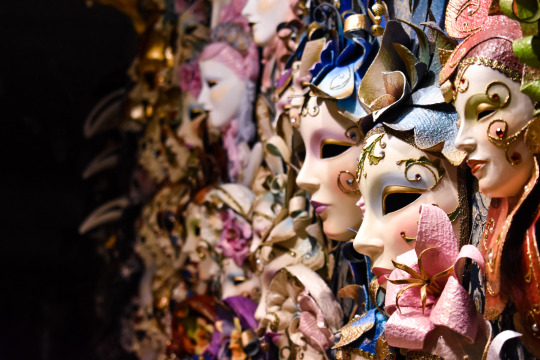
Venetian masks; a lucky shot I got from the storefront at night after spying a random guy taking similar picture on his phone
This year, I've made the decision of spending the Big Day in a different country, away from people I know and love. My mom said there are three things you should never hesitate to spend your money on: food, books and travel. I heeded her advice, like the obedient daughter I was.
As (yet another) birthday present, I finally bought myself a DSLR camera. Photos aplenty!
Prepared by my solo trip to Rome, I was relaxed and at ease. Venice met me with sun through clouds and sparkles of water.
Confused Rant (Skip at Will)

Accademia Bridge between San Marco and Dorsoduro
Before I start praising the beauty of the place, I need to vent out my disappointments and be done with them.
The biggest shock I got during this trip was upon realization that Venice is not Italy. It's completely separate; Venetians hang out the winged-golden-lion-on-red flags of their city not the country they live in. They boast their history, they live engulfed in the past magnitude of the Venetian republic, the dominion dictating its will to the region if not the whole ‘enlightened’ world.
‘Venetians’ are only those living on the cluster of islands; mainland (deprecatingly referred to by true Venetians as Mestre) is a completely different thing.
They are pridefully blindfolded by the achievements of the past - which are impressive, no doubt. But.
Venice doesn't seem welcoming. It's a fascinating place, for sure, but it's not one I'd chose to live in. It's slowly dying, despite the flocks of tourists crowding the tiny streets. Not just drowning, although this is a real problem - but losing its touch with reality, completely dependent on the inflow of money brought by tourists yet also soaked with condescending disdain. As if asking you to leave your money and get the hell out of their islands, thank you very much (Venice is surprisingly expensive; in a day, you get the habit of taking out a wallet when entering a church).

Venetian gondolas, wharf at Grand Canal
Unlike Rome, oblivious to your presence, living its life, Venice wears its colorful, gaily painted hospitality mask and a painful scorn underneath, struggling between the need to please you and get rid of your presence. This is exactly my problem with tourist towns - they need tourists, but the feeling of silent, woeful aversion toward non-locals is ever-present and oppressively strong. Thanks, I hate it.
However, this is also a puzzle piece that makes Venice unique. I'm not exactly an inexperienced traveler, yet I rarely feel this strongly about places. The contrast here is stark (especially when emphasized by a short trip to Verona - this, a definitely Italian town), and it makes the place even more vivid in my memory.
Lost in Venice: The Labyrinth, the Moments, the Rhythm
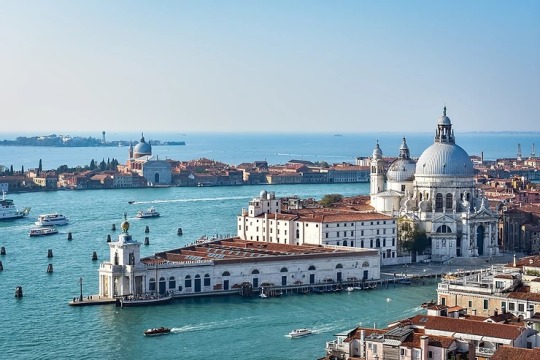
Venice is one of those cities known around the world. Its history, its geography, its multitude of symbols and names (La Dominante, Queen of the Adriatic, City of Canals, City of Bridges, City of Masks). It became the appellative to other cities around the world. It astonishes at first glance; it's unique
The infrastructure of Venice is impressive. The city literally is built on swamps, the marshy land that sinks underfoot, not to mention the weight of stone and brick buildings. To strengthen the soil, long wooden piles were installed to reach the firm clay underneath sand and mud. The wood used is still argued to be either alder trees from southern Baltics or Russian pines (probably the former). Either way, the wood is water resistant, given its century-old age and excellent preservation state.
To boot, Venice, surrounded by the sea, had no source of fresh water. Today, it is delivered from mainland. In the days of Venetian republic, a system of water cisterns that collected rain was constructed - hence the huge stone socles of wells on nearly every campo.
There is an anecdote roaming among the tour guides that some of these stone wells were stolen by insane tourists as souvenirs from Venice.

Venetian water cistern. The most unbelievable part is that, in the wells, the preserved water is probably still drinkable
The unusual geography gives way to even less usual architecture. Usually I'm pretty decent with maps and finding my way in a new city. Venice shattered my confidence to shards when I spent nearly two hours for a walk that should've taken no more than 15 minutes, and after finding myself going in circles. That was a start! The first day I arrived, I didn't have plans but wanted to have a bite and then get to San Marco - well, good luck with that. An hour later, despite living in 10 minutes walk from the piazza, I found myself in the middle of Castello, a completely different neighborhood of Venice - actually further from the destination.
Venice has 6 neighborhoods (sestieri): San Marco, San Polo, Cannaregio, Castello, Dorsoduro and Santa Croce.
San Marco is the only piazza in Venice. Although the place doesn't lack squares, they're all called campos, literally fields, since were used as such when Venice was built. The houses faced water, and it was the only way to get from one island to another (hence boat transportation system). Naturally, every island needed somewhere to grow food, and a church for the people living on each separate island. That's the trademark of Venetian urban planning: a campo with a church and a well for rainwater.
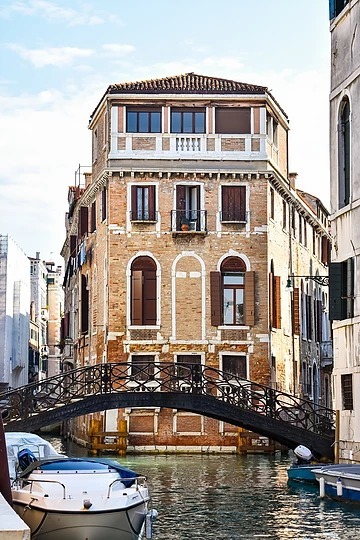
The house located on the peak of the island but looks like it is the island
I cannot remember the last time I was this fascinated by the way a place is built. It's literally a labyrinth, with dead ends of tiny private squares (never closed; you can get anywhere and knock on any door if you wish) and steps leading into water. Even with a clear idea of a direction in mind (and a first couple of turns you need to make remembered), you are bound to get lost. There are little to no identifiers (if you don't count the names of streets and campos, which tell you precisely nothing), with pointed signs reserved for major attractions like San Marco and Rialto.
Campos are often named after the churches that are or were standing here (signified by letter 'S', e.g. Campo S Maria Formosa).
Besides, some of the street names repeat (like Via del Forno, or literally Baker Street - specifically because bakers were important for every island, so most of the islands have one of those). It's best to avoid making appointments without specifying the sestiere.
Despite how scary this may sound, I relished in this feeling of being lost and aimless (control freak, present). It's a rare sensation of freedom, unobtrusive and calming, when you forget everything and just wander around with only a vague understanding of your final goal: food, coffee, sites, excitement!
I was cautioned GPS goes nuts in this water-stone labyrinth; it's not always the case, but having a paper map on you is still not a bad idea. And throw in an umbrella to the kit: Venice enjoys being rainy.
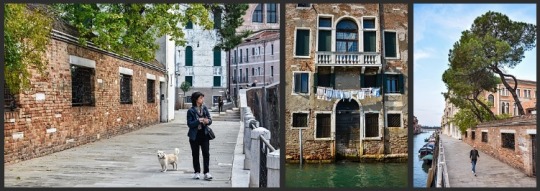
San Marco is (obviously) the busiest, most chaotic among the Venetian sestieri. Always full of tourists - even near midnight, even in its narrowest, smallest of streets. In comparison, Cannaregio and most of Dorsoduro look empty, almost deserted. The rest of the sestieri are relaxed, drowning in quiet slumber.
Every city is different and beautiful in its own right - there are people that make them unique. There are moments to witness in the quietest sestieri - and in the busiest of crowds.
A nun dressed in white descending the stairs of a half-blocked bridge, with a dove scared away from her feet. A group of middle-aged tourists abstrusely discussing the architecture of a baroque church in some incomprehensible language. A couple of elderly friends having a cozy chat at the bench on a tiny campo, with cigarettes smoking in their lazy fingers. A woman walking her minuscule dog along one of the wider canals near Rio dei Mendicanti. A colorful boat that looks like a toy bobbing on the busy waves of Cannaregio. Doors with quirky handles at the center of the frame, scattered all over the city. White-necked, grey-winged seagulls crowning the chimneys of old houses in desperate need of repainting.Colorful enjoyably shaped masks crowded in the shops. A couple sitting on the pavement at the water's edge, the woman going through the contents of her bag while the man smiles at passersby. An intricately cut wooden paddle in the showcase. An artist's workshop on full display with floor-level windows - or a woodworker's, hidden at the back corner of a narrow street. The most peculiar style of windows made of bottle bottoms (this can be seen all over Venetian region, in churches, palaces and old houses). Small crooked bridges with fragile rails. Gondolas hidden among the forest of striped palines, and gondoliers in striped shirts and straw boaters with red ribbons - smoking, chatting, singing. A kitten playing on the windowsill among the plants in pots. People sitting on marble stairs of the churches. Traditional hexagonal Venetian lamp posts of pink glass. Students sketching hastily in their notepads. A guy with the sun stuck in his ruffled dark hair photographing the lagoon. A group of men in acid-orange lifesavers' jackets smoking during break near their ambulance boats. A policeman bowing his head to a Madonna in a dilapidated wooden shrine. A messy old bookshop with human-high stacks of multi-colored books felled outside the door.

At times I think I've seen less than I could - because I kept getting lost in streets and thoughts.
The rhythm is everywhere. The lulling tempo of residential houses with their rounded windows. The dignified cadence of lofty Renaissance palaces (especially evident on Piazza San Marco, with its Doge's Palace and the Procuratie). The clear pulse of campos, churches, water wells and - most distinctively - bridges, small, grand, wide, connecting two or even three islands, crossing Grand Canal, leading into stores and homes.
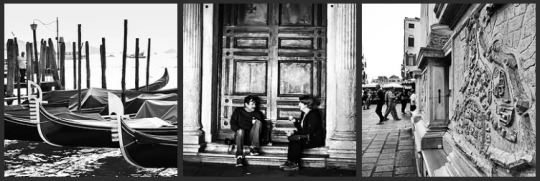
What to see in Venice:
San Marco sestiere:
piazza San Marco
basilico di San Marco
St Mark's Campanile
St Mark's clocktower
palazzo Ducale
Bridge of Sighs
Procuratie Vecchie and Procuratie Nuove (Museo Correr, Venice National Archeological Museum, Biblioteca Nazionale Marciana)
chiesa di San Zulian
chiesa di San Moise
campo San Luca
chiesa San Luca
Rio Tera dei Assassini
Scala Contarini del Bovolo
chiesa di San Salvador
Rialto bridge and terrazza panoramica
chiesa di Santo Stefano
Museo della Musica
campo Santo Stefano
Instituto Veneto di Scienze Lettere ed Arti
basilica di San Giorgio Maggiore (Isola San Giorgio)
Dorsoduro sestiere:
Accademia bridge
Santa Maria della Salute
fondamente Zattere ai Saloni (fondamente dei Incurabili)
chiesa del Redentore (Giudecca)
campo Santa Margherita
Santa Croce sestiere:
Constitution bridge
Venetian subway (3 stops in total)
San Polo sestiere:
chiesa di San Giacomo Apostolo (hosting musical museum)
San Simeon Piccolo
Cannaregio sestiere:
Santa Maria di Nazareth (Gli Scalzi)
Ponte degli Scalzi
La Maddalena
Madonna dell'Orto
La Scuola nuova di Santa Maria della Misericordia
chiesa dell'Abbazia della Misericordia
Ca' d'Oro
chiesa di Santa Maria dei Miracoli
Castello sestiere:
Scuola Grande di San Marco
basilica of Saints John and Paul
chiesa di Santa Maria Formosa
chiesa di Sant'Antonin
Venetian Arsenal
Sotoportego e Corte Delfina
basilica di San Pietro di Castello
Cimitero di San Michele (the island of St Michael)
The Brighter Side of Islands
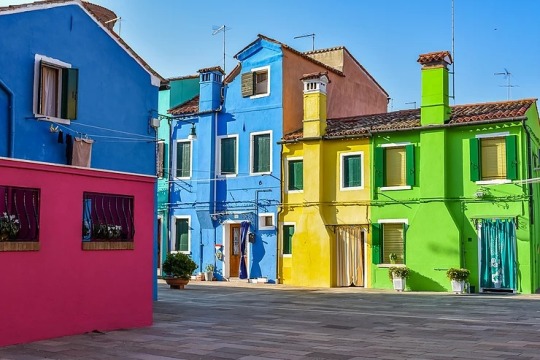
Burano
Before getting here, I planned spending my birthday roaming aimlessly around Venice, getting lost in its streets. But that is every day in Venice, so instead I bought a 24-hour public transport pass and went to see the islands.
The public transport in Venice is water-based. Aside from the trademark gondolas, there is a variety of yachts, motorboats, and, local signature vehicle, vaporettos. These come in different configurations depending on the routes - the best, in my opinion, have seats on the front, in the open air, serving partly as a tourist transport.
Throughout the trip, the weather in Venice was a bit moody, although thankfully not rainy. Saturday, the 13th, however, happened to be the sunniest day of the trip. Standing outside, wind tangled in my hair, barely able to see anything as sun threw handfuls of golden sparks into my eyes, I intensely enjoyed the feeling of speed, scent of salty water and marshy earth, the old stone and red roofs covering the patches of land scattered here and there.
Sunglasses come handy during such water-trips, unless temporary blindness is a viable option.

First stop was Murano, historical area dedicated to glass factories and, today, featuring numerous showcases of artists that are not unlike museums full of oddest, most peculiar and wondrous glass sculptures. Walking along the quay, it is possible to find an artshop that has free tours on glass sculpture production.
For me, Murano was the area's first glimpse of a true Mediterranean palette: bright whites, pure blues and fresh, light greens. Waiting in line for the tour, I delighted in the view of the lagoon. Festive, clean yachts, all white gleaming surfaces and polished wooden panels the color of dark honey with even darker veins. Neat paths and lanes covered with white smoothly round gravel. Soigne yards with delicately trimmed bushes. Blue-and-white striped mooring posts (aka palines, another one of Venetian symbols on par with gondolas and bridges).
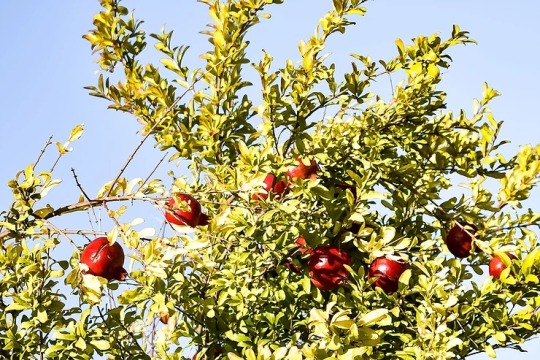
Pomegranate tree full of red fruits - looks just like Charles Demuth's 'Plums' (1925)
The inner Murano has a different feel than the seaside: it's much wider. Besides, Murano has much less canals - I saw literally one, the rest is all streets and inner patios, quiet, serene, bathed in sun and empty; the closest place in Venice must be the northern side of Cannaregio, closer to the old Jewish quarters.
Waiting lines to get out of Murano are enormous. Be prepared to spend at least half an hour, whether you leave for Venice or for Burano, the next-favorite stop.
You can skip Murano if not very interested in glass and in order to save some time. Skipping Burano, on the other hand, is a sin for any traveler.
The houses of this small island are unique: each has its own designated color, which is ruled by the local government to preserve the look of the town - truly a museum under the open roof. Burano is a study of cheerful, bright colors. It's fun catching people in front of houses the color of their clothes.
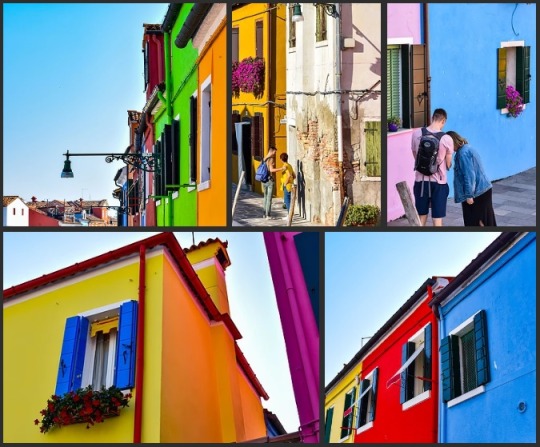
Burano is widely known for its textiles - the main street running inland from the wharf is covered in the assortment of shops selling lace umbrellas (souvenirs and human-sized), fans, corsets, scarves et cetera. As the shops give way to homey cafes and quaint restaurants, the crowd thins out, flowing along the splitting canals.
Real-life drama broke out on the quay. A Japanese girl dropped her phone into one of the canals - and she actually managed to fish it out using a scoop-net provided by some compassionate local. I was observing while pity and mirth dueled to be plastered all over my face.
Behind the Burano main streets, a much quieter area runs along the quay at the murmurous accompaniment of a street singer playing something sweetly romantic. This is an enchanted area for picnics - spacious green lawns under the rich crowns and low branches of firs, warm pale-yellow sun, cool stone parapet, sprinkles of light glistening off the waves and drops of water from the tumultuous waves, seagulls touching wings over the waters and fast motorboats passing by.
Take off your shoes to enjoy the fresh breeze and let your feet some rest. Have a glass of Prosecco and a seafood salad on the central square of the island, near chiesa di San Martino. Awe at the leaning tower protruding from the colorful rooftops (actually, Italy is full of those; Pisa is just the most famous).
Torcello offers little in comparison - just an old church of Santa Fosca (XI-XII centuries), an even older cathedral of Santa Maria Assunta (639 AD) surrounded by the garden of ancient sculptures (including Trono di Attila) and its belltower with the view of the marshes of the Venetian lagoon (truly makes one imagine what this place was before an empire was built upon the morass). Leisurely crowds stroll to visit the ancient sites, passing by Ponte del Diavolo, an unfinished bridge remarkable for its lack of handrail.
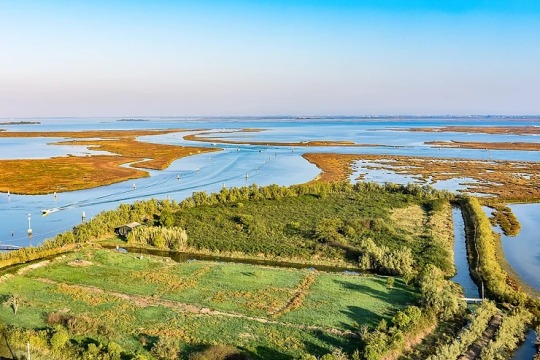
Panorama from the top of Santa Maria Assunta belltower, Torcello
Way back to Venice (and Lido, my final stop on this island run) was marked with sun hovering over the horizon, throwing a haze of pink-blue blanket over the lagoon. In this tremulant light, the dark shadows of palines protrude from the soft waters, ragged and cankered.
Palines mark the waterpaths like the posts of highways; grouped in three, weathered, dark from time and water, partly rotten to the point of only the upper half remaining. They are bizarre, surreal as they bask in the translucent dusk, a mirage reflected in the water amalgamating with the sky.

Lido gained fame for its long beach. Facing the open Adriatic sea, it makes a wonderful case for both sunrises and sunsets. Pity, I was 10 minutes too late for the sunset (I blame the unhurried vaporettos), and instead only caught the last glimpses of it
Staying in Venice, you forget about such integral part of modern life as cars. Not even bicycles make sense on the islands connected with innumerable bridges, most of which have stairs, the tiny streets that at times allow only one person, and the crowds that flock them. For this reason, on Lido, I caught myself staring for consecutive five minutes at a bus, feeling something was wrong but unable to pinpoint what exactly. Until it hit me: people were standing at a crosswalk waiting for the car flow to subside. For a person living in a metropolis, this is a weird feeling to experience.
Lido sports the ambiance of a typical tourist resort near the sea - very unlike the deeply historical, proud and arrogant Venice.
The final touch of the day was dinner at La Colombina, a Michelin restaurant found on the side street of Strada Nova. I relished in the sensation of being cared for: an assortment of traditional Venetian dishes by the recommendation of maitre d'hotel and a glass of white wine offered by a sommelier followed by black coffee served as good as in Sarajevo.
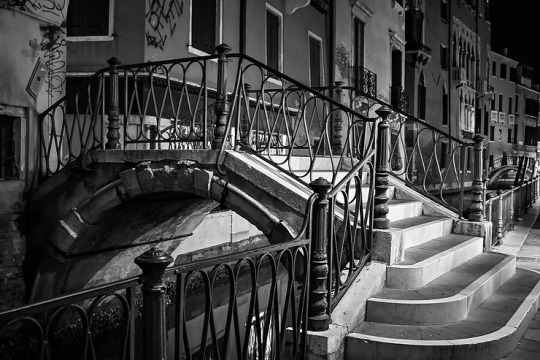
Bridge near San Zaccaria station, Venice
Venice is the water-borne city, and experiencing it from water is an integral and wholesome experience, whether a gondola ride or a trip down Grand Canal (better not to mix those, traffic on the central Venetian waterway is competitive). A night vaporetto shows off the lighting wonders, from the rigorous black-and-white facades to the flirtatious pinks and warm yellows of palaces turned posh hotels.
Getting home from the vaporetto station, I decided I should be able to find the way on my own, without being glued to the screen of my phone. I was wrong, obviously; after an hour I caught myself staring at a vaguely familiar balcony that I passed under ten minutes ago. That was when I realized I've uncovered the true character of Venice and finally let go of all hope finding the way on my own in this city. A profoundly enjoyable awareness.
What to see on the islands:
glass factories and artshops (Murano)
Cometa di vetro (Murano)
chiesa di San Martino and leaning belltower (Burano)
Ponte del Diavolo (Torcello)
chiesa di Santa Fosca
cathedral of Santa Maria Assunta and belltower (Torcello)
Museo di Torcello (garden of sculptures)
Trono di Attila (Torcello)
beach Lido de Venezia
Verona: Consistency Through the Ages
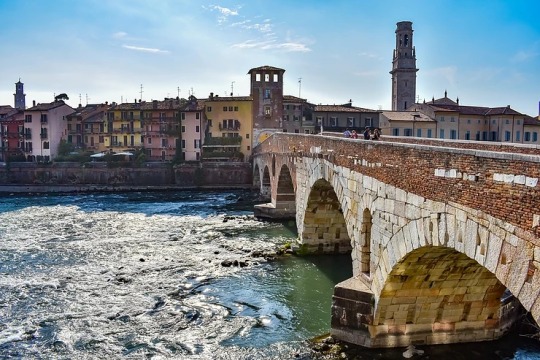
Ponte Pietra, river Adige, Verona
At first I planned on visiting Padua, but a girl at my hotel's reception was surprised enough to convince me to change the destination to Verona, a small, well-preserved medieval town an hour inland away from Venice.
It is my guess that most people come to Verona because of one minor play by some insignificant English playwright. Naturally, I was prepared to pay my respects to Juliet's abode, yet it wasn't the best place I've seen in Verona (it didn't even cut to top ten).
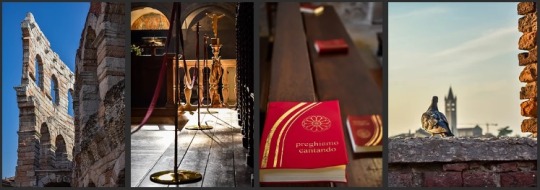
I am weak toward cities that have a clear route encircling all the major attractions, as if it was built for exploration. Verona uncovers historical layers through its architectural milestones. Pre-Christian era is embodied in Roman edifices including the local colosseum, Arena di Verona (third biggest after Rome and Capua), Porta Borsari (ancient gate in the city wall surrounded by medieval houses and oleander bushes) and Teatro Romano, a grim, gray structure across Adige river and up the hill. The Romanesque Cattedrale di Santa Maria Matricolare featuring two reconstructed Paleo-Christian churches and one of the oldest functioning libraries in the world is a study of several ages of early Christianity. The Gothic Arche Scaligere is so intricate one can spend days studying its decorations, and the red-brick Castelvecchio, the powerful square construction of war explains the military aspirations of the Medieval Verona.
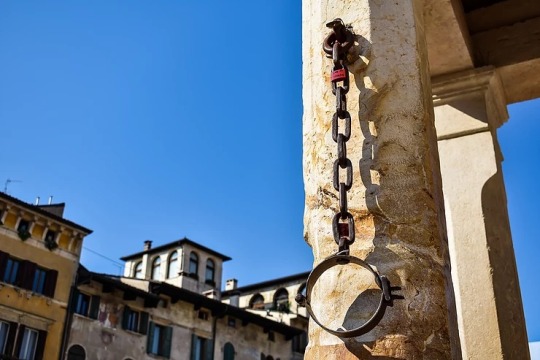
Piazza delle Erbe (literally Herb Square) features statues and fountains of different eras dating back to Roman rule through the Middle Ages. The market in the middle of piazza is still selling fresh vegetables and herbs, the epitome of integrity (a pleasant change from modern inconsistency)
In the train, I by chance overheard a conversation by fellow tourists who were also going to Verona and discussing the places to eat. That's how I got my lunch destination. It appears, in Verona, horse meat is a thing.
There's much less people compared to Venice; a breath a fresh air (both figuratively and literally). Quiet old streets, paved in uneven stones, lead to the tumultuous Adige and the white Ponte Pietra.
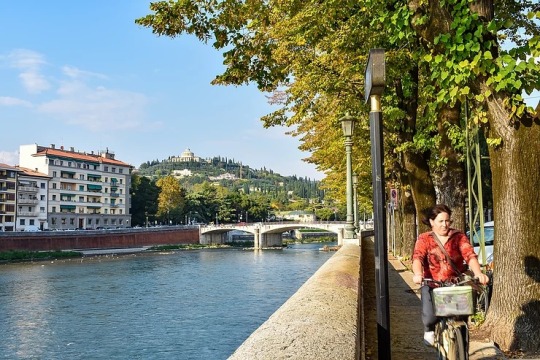
Compared to Venice, this is real Italy: a river across the town, enchained in high stone walls, manacled by elderly bridges; motley planes along the quay, dappled in summer sunlight; old red brick castle with Gothic merlons along the walls
The walk around the city is calm, warm and fits in the span of several hours. Quite an enjoyable detour.
What to see in Verona:
Porta Nuova
piazza Bra
Arena di Verona
palazzo Barbieri
palazzo della Gran Guardia
Casa di Giulietta
piazza delle Erbe
Madona di Verona
Torre dei Lamberti
piazza dei Signori
Arche Scaligere
chiesa di Sant'Anastasia
Ponte Pietra
Teatro Romano
chiesa dei Santi Siro e Libera
castel San Pietro
cattedrale di Santa Maria Matricolare
chiesa di Sant'Eufemia
Porta Borsari
Castelvecchio and its bridge
Arco dei Gavi
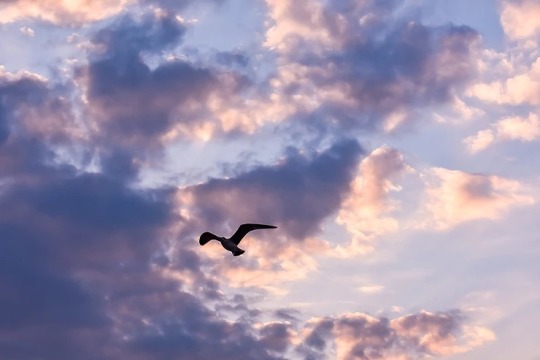
Coming back to Venice, I managed to catch sunset at San Marco. The seagulls here are fierce and beautiful creatures; it's not always a good idea to carry food around
What to eat:
cicchetti (bite-sized snacks common for bacari, traditional Venetian bars)
sarde in saor (pickled fried sardines with onions)
baccala mantecato (cod cream)
risotto al nero di seppia (black rice and seafood)
risi e bisi (rice and peas soup)
bigoli in salsa (pasta with onions and salt-cured fish)
fegato alla veneziana (liver and onions)
moleche (fried small crabs)
scampi alla veneziana (shrimps)
caparossi a scota deo (clams)
scampetti con polenta (baby shrimps served on polenta)
baicoli (biscuits)
fritole venessiane (sweet pastry served during Venetian Carnival)
pincia (sweet pastry)
buranelle (sweet biscuits)
zabaglioni (egg dessert)
What to drink (alcohol is important in Venice - drink your days away):
Aperol Spritz (Venetian signature cocktail, refreshing and fun)
Bellini
Prosecco (white wine, commonly sparkling)
Soave (white wine, good with fish dishes)
Orto di Venezia, Venissa (white wines)
Valpolinella and Amarone (red wines)
vino della casa (homemade wine, usually less expensive and rarely served in traditional wine glasses)
Final Word

Sunset at piazza San Marco
Venice is a city of its own character, sometimes oblivious, sometimes arrogant and condescending - but it surely has the right to be so. Hit some sweet Vivaldi, order a glass of Aperol Spritz at bacaro - and let yourself get lost in this bizarre, lovable chaos.
4 notes
·
View notes